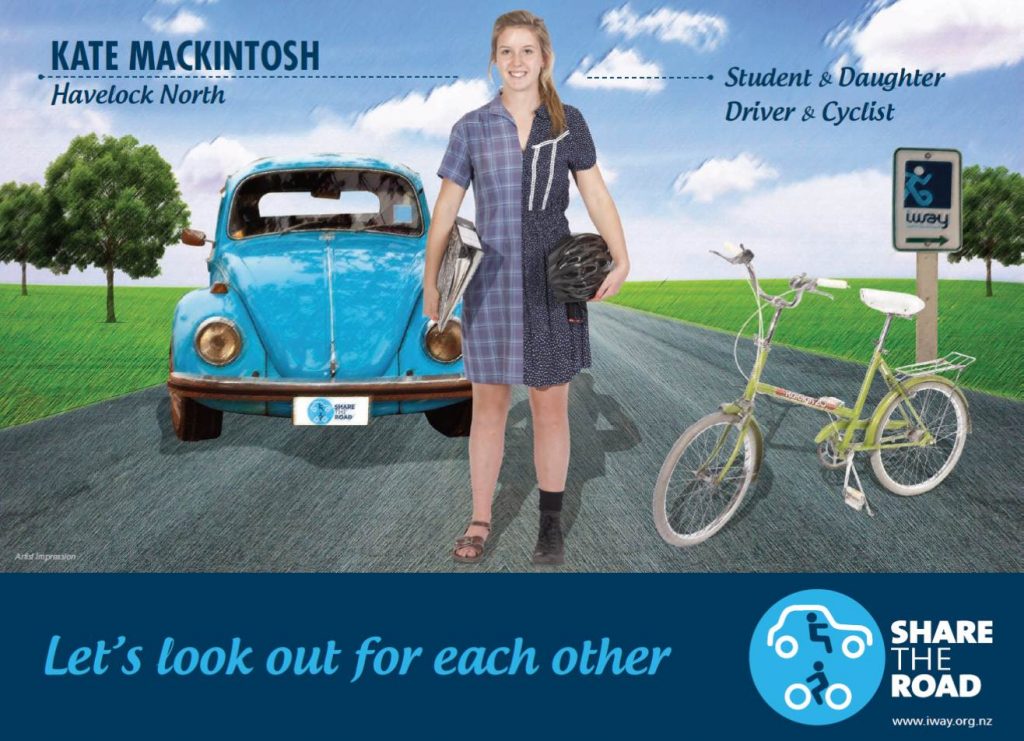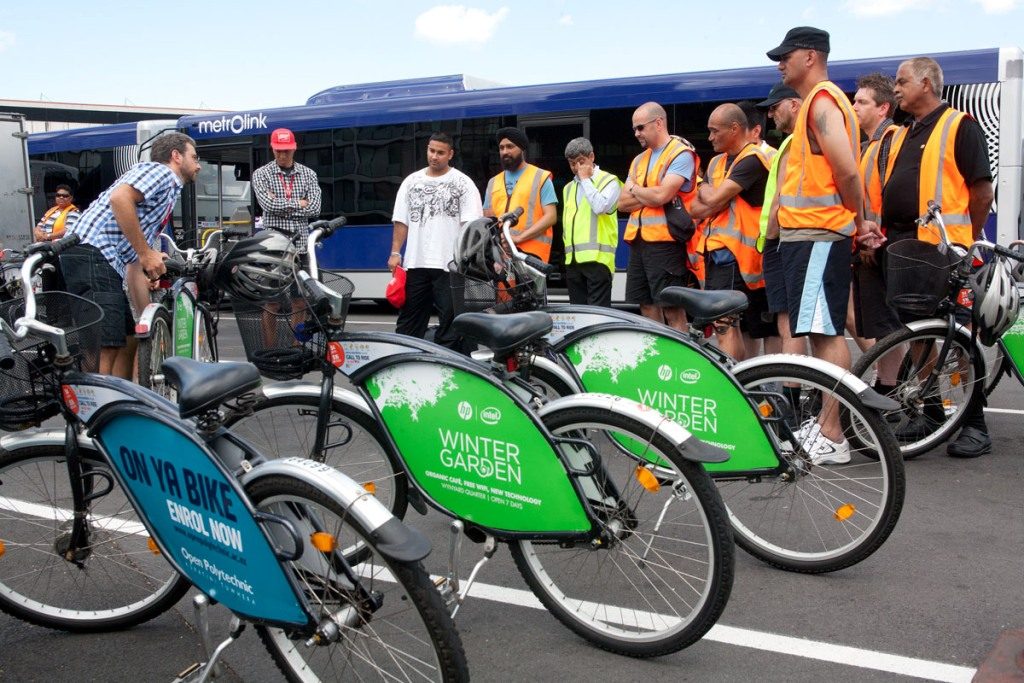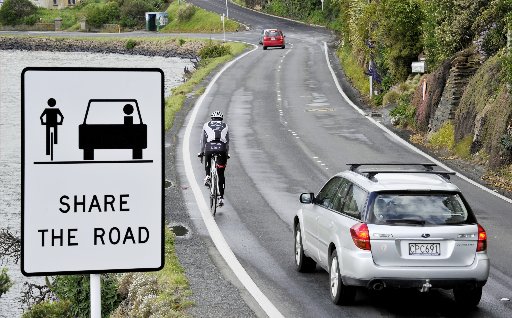In amongst the feeding frenzy regarding cycle safety last week, the NZ Transport Agency released a new advertising campaign encouraging motorists to better share the road with people cycling. The campaign is designed “to personalise and humanise people cycling so that motorists see them as real people who have a right to share the road safely”.

The idea is to use images of everyday cyclists wearing T-shirts labelling them as someone’s loved one, such as a son, father or aunt, to urge drivers to share the roads safely with them. It’s not completely new for New Zealand; a similar campaign has been running in Hastings, one of NZTA’s Model Walking/Cycling Communities (and in fact, won an award in 2012). One thing I like about the Hastings campaign is that they also identify the characters as both drivers and cyclists, highlighting the fact that many people do both.

As I’ve alluded to before in this blog, I’m not a big fan at all of the term “cyclist”, as it seems to get the average punter viewing people on bikes as quite different to them. So I’m generally for any approach that tries to remind everyone that we’re all in this together. I hope that many of the images used by NZTA will be a bit more “everyday” than the picture above, which seems to perpetuate “cyclists” as “lycra lads”.
Not everyone has been convinced of its merits. Clive Matthew-Wilson, editor of the car review website The Dog and Lemon Guide (who for some reason gets called on regularly to comment on road safety) is sceptical that a simple advertising campaign will make any difference to road user behaviour. Patrick Morgan from the Cycling Advocates Network (CAN) also agrees that more is needed, especially in regards to better cycling infrastructure.
In one sense they’re right, as the research is inconclusive about the effectiveness of road safety advertising (although it is a tricky thing to assess in isolation, and very little proper study of it is done anyway). However one thing I like about “official” road safety advertising focused on cycle safety is that it helps to legitimise cycling (and people who do it) as a valid activity on our roads. We hear so much rubbish calling for cyclists to get off the road or “pay their way”, so it is important that agencies in a position of power say “get over it – cycling is here to stay”.

Another way to get better understanding between road users is get them together to see the view from the other side. This is the thinking behind CAN’s “Road User Workshops”, which have been bringing together regular riders with professional bus and truck drivers to discuss on-road issues and then try each other’s vehicles out. These workshops have been running all around New Zealand (including one in Chch in 2010), and The Herald featured the most recent workshop in Auckland recently. This “view from the other seat” seems to be a very effective way to generate empathy and goodwill – how might we do a similar exercise for the average car driver?
NZTA’s campaign will initially run in Auckland, Hamilton, Wellington and Christchurch with a view to expanding it to other regions next year. Already I’ve heard the radio advert playing locally.

What do you think of NZTA’s new cycle safety campaign?

Nice to see that NZTA are doing something in terms of road safety, but it would be nice if they would put their money where their mouth is. There are many places around NZ where with a little signage, safety could be dramatically improved, but unless a proposal fits some planning rule to the tee they find more reason why not to improve safety. the budget spend on safety runs about number 4 on NZTA priorities which is disappointing.
NZTA & CCC approved a dangerous non-complying road network for the new Living G Yaldhurst Zone. Required Cycle Lanes came to abrupt ends with pinch points and cyclists being squeezed into 3.2m wide traffic lanes with buses, trucks & cars. Right turning medians & safety parking kerb build-outs were also eliminated adding to the dangers.
Only 3 1/2 years of pressure from the affected community prompted an independent safety audit that confirmed “10 (ten) serious and significant frequent death and serious injury safety issues” plus numerous “moderate minor injury safety issues”. Hopefully our new Elected Council have the metal to insist on these dangerous non-complying roads being remedied before vesting. Criminal culpability might otherwise apply to the predicted deaths and injuries.
0.8m Average bike width
+1.5m Recommended bike/car clearance
+1.8m Average car width
=4.1m. (numbers from a quick and dirty Google search)
This would indicate to me that the safest and recommended course of action is to cycle in the middle of the lane.
To A Brown. You are correct plus buses (it is a public bus route) are around 3.0m with mirrors I understand. It also has a large commercial precinct so will have many trucks using the dangerous roads.
The developers SUPPORTING traffic report stated “vehicles are expected to yield to vehicles coming the other way rather than “squeeze” cyclists”. The traffic engineers the affected public engaged (Abley Transportation) to challenge the council on these dangers stated the above analogy was car centric and wrong. The vehicles are actually required to yield to the cyclist (in the middle of the lane as you point out), not the vehicles coming the other way.
Council staff have been relentless in their covering up and continued support of the known dangers they erroneously approved. Should the frequent deaths and serious injury occur as Dr Turner predicts in his safety audit then criminal culpability is a real possibility.
really liking this campaign which | think is a lot more affective that ‘drive social’ which was, admittedly not cycling specific but was too subtle for the sort of people who are thye problem when it comes to consideration of others. This campaign reinforces that cylists are actually people like everyone else
The AA in the UK have taken it one step further with their “Now you see me” campaign.
http://www.stuff.co.nz/motoring/videos/9824275/I-m-naked-now-you-see-me
Another “humanising bike riders” campaign; this time in the US – quite good: http://www.peopleforbikes.org/pages/travel-with-care